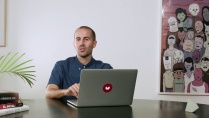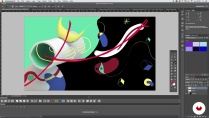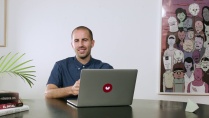Animation of TV Bumpers with Motion Graphics
A course by Fabio Medrano , Motion Graphics Designer

Animate broadcasting pieces with Cinema 4D, After Effects, Arnold Render, and Photoshop
Fabio Medrano, animation and motion graphics specialist, teaches you to create a corporate bumper or television ID with Cinema 4D, Arnold Render, and Photoshop.
Learn the principles of animation, as well as audiovisual production tricks, shot-by-shot composition, lighting, and post-production, to improve your pieces exponentially.
What will you learn in this online course?
23 lessons & 29 downloads
- 94% positive reviews (143)
- 3,107 students
- 23 lessons (3h 45m)
- 29 additional resources (19 files)
- Online and at your own pace
- Available on the app
- Audio: Spanish
- Spanish · English · Portuguese · German · French · Italian · Polish · Dutch · Turkish · Romanian · Indonesian
- Level: Intermediate
- Unlimited access forever
What is this course's project?
Create your own TV bumper with motion graphics.
Projects by course students
Who is this online course for?
Animators, designers, illustrators with a base in 3D, and anyone who wants to immerse themself in the world of motion design and discover animation, lighting, and rendering techniques with Cinema 4D and Arnold Render.
Requirements and materials
To take this course, you need a working knowledge of both Cinema 4D and Photoshop.
Regarding materials, you need a computer installed with Cinema 4D, Arnold Render, Photoshop and After Effects, with a mouse or graphics tablet, paper, and a pencil.

New to Adobe After Effects? In that case, we recommend taking Domestika Basics courses to learn how to use the software: Introduction to After Effects.
Reviews

Fabio Medrano
A course by Fabio Medrano
Fabio Medrano is an animations director and motion designer. Although he began studying production and audiovisuals, curiosity gradually led him towards art direction and animation. He is what the industry calls a generalist professional, since in addition to creating, modeling, animating, and lighting, he also enjoys the intermediate rendering processes, the creation of textures, and the final composition.
Throughout his career he has carried out projects for brands such as Orange, Nestlé, PlayStation, Pepsi, Bezoya; corporate image pieces for television channels such as Canal +, Nova, Discovery Channel, Cuatro, Antena 3; visuals for concerts by groups like Skrillex; mappings; and apps, among others.
From a personal point of view, he is passionate about travel, and tries to capture his experiences around the world in his work through color, textures, and environments. He is also in love with cinema and comics, two things he draws from when thinking up new solutions when composing an image, lighting design, symbology, the use of costumes, props, and more.
Content
-
U1
Introduction
-
Presentation
-
Influences
-
-
U2
Basic concepts of animation
-
Timing, Spacing and types of curves
-
Deforming the mass
-
Anticipation, action and reaction
-
-
U3
Composition of the plane, framing and optics
-
The plane composition
-
Camera, angle and optics
-
-
U4
Setting the foundations of our piece
-
Search for references
-
Creation of a Mood Board and base concept
-
-
U5
The time to create
-
The sketch and the storyboard
-
The first animatic
-
We begin to polish plane to plane I
-
We begin to polish plane to plane II
-
We begin to polish plane to plane III
-
Time to light I
-
Time to light II
-
Materials and textures I
-
Materials and textures II
-
Render and pass settings for the compo in After Effects
-
-
U6
Giving the last touch
-
We adjust color and light levels
-
Post production tricks
-
Final details of the final design
-
Codecs and formats
-
-
FP
Final project
-
Animation of television widgets with Motion Graphics
-
What to expect from a Domestika course
-
Learn at your own pace
Enjoy learning from home without a set schedule and with an easy-to-follow method. You set your own pace.
-
Learn from the best professionals
Learn valuable methods and techniques explained by top experts in the creative sector.
-
Meet expert teachers
Each expert teaches what they do best, with clear guidelines, true passion, and professional insight in every lesson.
-
Certificates
PlusIf you're a Plus member, get a custom certificate signed by your teacher for every course. Share it on your portfolio, social media, or wherever you like.
-
Get front-row seats
Videos of the highest quality, so you don't miss a single detail. With unlimited access, you can watch them as many times as you need to perfect your technique.
-
Share knowledge and ideas
Ask questions, request feedback, or offer solutions. Share your learning experience with other students in the community who are as passionate about creativity as you are.
-
Connect with a global creative community
The community is home to millions of people from around the world who are curious and passionate about exploring and expressing their creativity.
-
Watch professionally produced courses
Domestika curates its teacher roster and produces every course in-house to ensure a high-quality online learning experience.
FAQs
What are Domestika's online courses?
Domestika courses are online classes that allow you to learn new skills and create incredible projects. All our courses include the opportunity to share your work with other students and/or teachers, creating an active learning community. We offer different formats:
Original Courses: Complete classes that combine videos, texts, and educational materials to complete a specific project from start to finish.
Basics Courses: Specialized training where you master specific software tools step by step.
Specialization Courses: Learning paths with various expert teachers on the same topic, perfect for becoming a specialist by learning from different approaches.
Guided Courses: Practical experiences ideal for directly acquiring specific skills.
Intensive Courses (Deep Dives): New creative processes based on artificial intelligence tools in an accessible format for in-depth and dynamic understanding.
When do the courses start and when do they finish?
All courses are 100% online, so once they're published, courses start and finish whenever you want. You set the pace of the class. You can go back to review what interests you most and skip what you already know, ask questions, answer questions, share your projects, and more.
What do Domestika's courses include?
The courses are divided into different units. Each one includes lessons, informational text, tasks, and practice exercises to help you carry out your project step by step, with additional complementary resources and downloads. You'll also have access to an exclusive forum where you can interact with the teacher and with other students, as well as share your work and your course project, creating a community around the course.
Have you been given a course?
You can redeem the course you received by accessing the redeeming page and entering your gift code.
















buen curso básico pero se centra mucho en cinema 4d esperaba mas de after pero para iniciar en 4d es muy bueno
(y)
I wish there was more on the modelling of the scene. Otherwise ok with the motion graphics part.
I liked it so much
Great course!